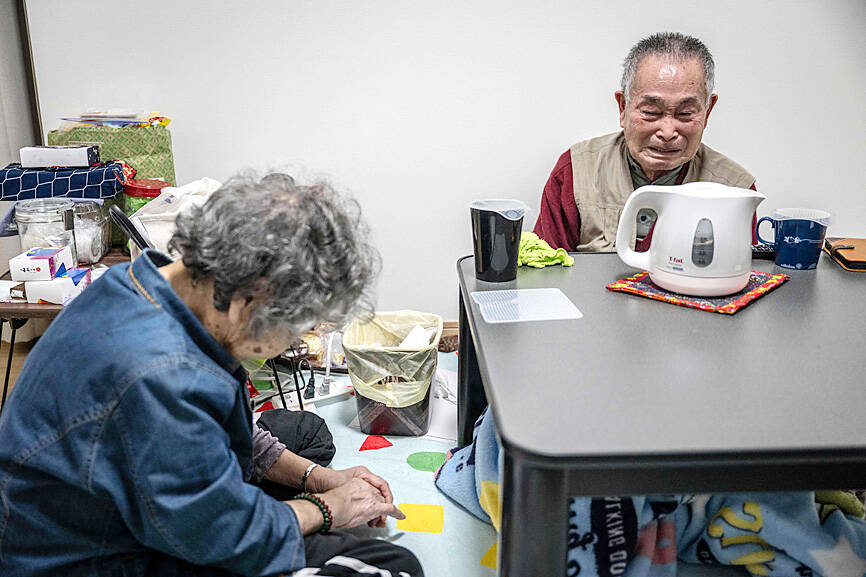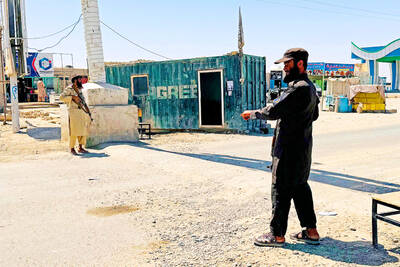Before the earthquake changed everything, 83-year-old Sueko Naka from Japan’s remote Noto Peninsula wished to live out her life at home, watched over by an altar to her ancestors, but a year after a magnitude 7.5 quake and its aftershocks devastated the region, she lives in a small temporary unit with her husband and daughter, facing an uncertain future.
“When I imagine I might die here, I can’t sleep well,” Naka said among her minimal belongings in the newly built dwelling in the city of Wajima.
“I guess I have to accept reality. We have a place to stay,” she said.

Photo: AFP
The earthquake on New Year’s Day last year was Japan’s deadliest in more than a decade, claiming nearly 470 lives.
About half of the victims were killed in the disaster itself, which brought tsunami waves and sparked a huge fire in Wajima’s city center, burning down a historic market.
The rest perished later, as hundreds of aftershocks and cold weather compounded stress for survivors, including 40,000 people — many elderly — evacuated to shelters in school gymnasiums and community centers.
A year later, Ishikawa Prefecture still quivers with aftershocks, stoking fears of another huge jolt. Unprecedented rains in September also unleashed severe flooding in Noto, resulting in 16 further deaths.
Today, more than 200 people still live in shared emergency shelters, while thousands of others like Naka are in accommodation units meant as a stop-gap solution.
Even in the fourth-biggest economy, reconstruction has been slow, with only one-quarter of Wajima’s heavily damaged buildings demolished so far.
The quake ripped up roads and triggered landslides, making it difficult for heavy equipment to traverse the rural peninsula on the Sea of Japan coast.
Its most remote parts give the impression of a large construction site dotted with empty homes, some at slanted angles.
An army of demolition crews operate heavy trucks on pavements warped into wavy, uneven surfaces, but locals say much more is still needed to clear the destruction.
After the earthquake “we received various forms of external support, and there was an emerging sense that everyone was going to start over, but the torrential rain swept away everything, and people had to go back to square one,” Wajima city official Yasuaki Ipponmatsu said. “That was very difficult.”
New Year is an important period of rest for Japanese families, so when the strongest of several quakes hit on the afternoon of Jan. 1 last year, Naka was at home with her husband.
Its force knocked them to the floor as the foundations of their house dropped 50cms.
“A big roar came from the house next door. Their house crashed down on ours, leaning on it,” Naka said. “I thought: ‘This cannot be.’”
The couple’s family home was among the newer structures in their Wajima neighborhood, built after a magnitude 6.9 earthquake in 2007 destroyed their previous house.
“When I remember what happened, I can only cry,” Naka said.
The quake significantly damaged more than 100,000 buildings and completely destroyed another 6,000 across Ishikawa Prefecture.
The disasters and slow recovery have prompted many Noto Peninsula residents to start new lives elsewhere, aggravating an existing depopulation crisis as Japan’s population ages.
About 21,000 people now live in Wajima, 2,500 fewer than last year. A decade ago the city was home to nearly 30,000.
“Would they decide to build new homes and return? I think it will be hard,” said Chugo Maruyama, who helps operate a large evacuation shelter in Suzu, next to Wajima.
“I think our town could be headed straight for extinction,” the 70-year-old said.
The community is exploring ways to encourage young people to stay and rebuild, but the challenges are daunting, with rice fields ruptured and filled with sediment, and ports and irrigation canals damaged.
The disaster has also scattered Naka’s family. She and her husband shared their home with their son-in-law and three grandchildren, but they now live elsewhere.
Their 53-year-old daughter Miyuki Kijima moved back to Wajima to look after the elderly couple.
When she thinks of the repeated disasters the Noto Peninsula has suffered, she asks: “Why only Wajima, why again?”
“We want to repair our home and live there again, but what if it happens again after we repair it?” she said.
For Kijima, the New Year is now “only scary.”
“All I want is for the seven of us to spend our lives together,” she said.

‘EYE FOR AN EYE’: Two of the men were shot by a male relative of the victims, whose families turned down the opportunity to offer them amnesty, the Supreme Court said Four men were yesterday publicly executed in Afghanistan, the Supreme Court said, the highest number of executions to be carried out in one day since the Taliban’s return to power. The executions in three separate provinces brought to 10 the number of men publicly put to death since 2021, according to an Agence France-Presse tally. Public executions were common during the Taliban’s first rule from 1996 to 2001, with most of them carried out publicly in sports stadiums. Two men were shot around six or seven times by a male relative of the victims in front of spectators in Qala-i-Naw, the center

Canadian Prime Minister Mark Carney is leaning into his banking background as his country fights a trade war with the US, but his financial ties have also made him a target for conspiracy theories. Incorporating tropes familiar to followers of the far-right QAnon movement, conspiratorial social media posts about the Liberal leader have surged ahead of the country’s April 28 election. Posts range from false claims he recited a “satanic chant” at a campaign event to artificial intelligence (AI)-generated images of him in a pool with convicted sex offender Jeffrey Epstein. “He’s the ideal person to be targeted here, for sure, due to

DISPUTE: Beijing seeks global support against Trump’s tariffs, but many governments remain hesitant to align, including India, ASEAN countries and Australia China is reaching out to other nations as the US layers on more tariffs, in what appears to be an attempt by Beijing to form a united front to compel Washington to retreat. Days into the effort, it is meeting only partial success from countries unwilling to ally with the main target of US President Donald Trump’s trade war. Facing the cratering of global markets, Trump on Wednesday backed off his tariffs on most nations for 90 days, saying countries were lining up to negotiate more favorable conditions. China has refused to seek talks, saying the US was insincere and that it

As Elon Musk called one of US President Donald Trump’s top economic aides a “moron,” the White House on Tuesday declared that “boys will be boys.” Musk and long-time Trump trade adviser Peter Navarro have been squabbling publicly over Trump’s decision to impose sweeping tariffs on most of its trading partners. The move has triggered a market sell-off and prompted analysts to wonder if the US is headed into a recession. “Look, these are obviously two individuals who have very different views on trade and on tariffs,” White House press secretary Karoline Leavitt said. “Boys will be boys, and we